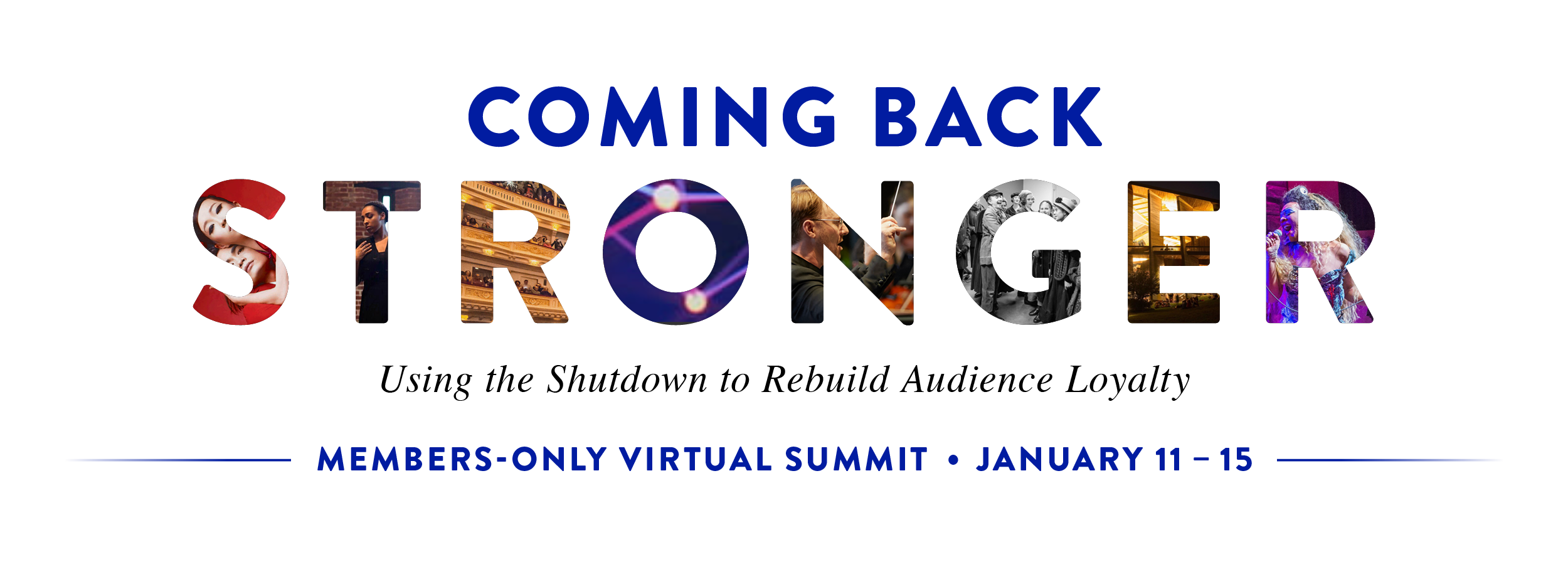Takeaways from Demystifying Digital Monetization Session
For our “Demystifying Digital Monetization” summit, we laid out the research we have conducted over the past two months on the development of digital monetization in the arts. We explored the range of digital activities arts organizations have engaged, what seems to be working, and finally what we should take with us beyond the pandemic.
Below is an abbreviated set of takeaways. ABA members, check out the full recap on our member site, including case studies from Philadelphia Orchestra, Pacific Northwest Ballet, National Theatre, and more.
Assessing The Situation
The first item on our agenda for the day was to provide an overview of the rapid transformation the arts world has undergone during the pandemic, specifically around their digital monetization strategy. As one theatre director ABA spoke to during our research put it: “Before the pandemic, we created a plan to expand our digital work that spanned five years. Within three months of the pandemic, we had accomplished all the targets we had planned to take in five years.”
At this point, most arts organizations are trying to monetize digital. In our recent benchmark survey, a majority of respondents are monetizing digital content through earned income, contributed income, or both. And while 31% are not currently monetizing digital, nearly half of this group hopes to do so in the future.
With many organizations in the process of experimentation with digital, there are still a lot of questions around how to monetize effectively. Our session focused on four major areas of concern for arts organizations in this space:
How target audience shapes approaches to digital content
How to approach packaging and pricing
How to select the appropriate video streaming platform
How to prepare for changes in audience needs and behavior as we begin to re-open
This leads us to the reality of digital monetization: few organizations will see direct revenue from digital that exceeds costs to produce. There are, however, several important benefits beyond earned income:
Donation success: donations have been a surprise upside for digital content, and often the biggest success for monetization
Audience learning: collect data and learning about audience behavior has made your enterprises more valuable
Improving economics: when we do return, the economics of digital efforts will likely improve, as it will be supplementing live earnings rather than bearing the full burden of operating costs
Future value: it is important to be thinking now about the future role digital will play, which is likely to be an indirect path to revenue
Defining What We Want To Achieve
A crucial first step in shaping your digital monetization strategy is to identify your target audience. When comparing three different arts organizations, we see how their “who” (target audience) and “why” (type of monetization they are aiming towards) shapes the way they approach creating and packaging digital content — the “how.
Of course, these organizations did not turn away other audiences, but their target audience - and their monetization objective led them to ask very different questions about how they would execute on digital content. These shaped the approach they took and kept their efforts focused, rather than scattered.
Fine-Tuning Pricing and Packaging
In our research, we saw a range of models for monetizing digital work during the pandemic, from individual ticket sales to full subscription packages.
This does not mean that it is necessary to pick just one model — to the contrary, there is reason to believe that it is worth choosing several of the options at once. We recommend combining models as much as possible to maximize revenue. Realizing revenues that exceed costs can be a challenge, so we have to find ways to reach more audiences and increase their spend.
Using different revenue models in combination can attract a large audience who will purchase content in the way they want while also maximizing their willingness-to-pay.
What Should We Take Beyond The Pandemic?
While it may be tempting to lay down the burden of digital once we return to live, we at ABA believe that our needs are too great, the opportunity too large, and the capabilities we have developed too valuable to decommission the digital engine.
Digital seems well-suited to the challenges that have been present in the arts for years now, including declining subscriber bases and the need to attract more new, and particularly younger, audiences and donors. Digital content can be a great avenue for experimentation, especially as we look to reinvigorate our artforms with innovative new expressions of art.
Once again, having a target audience will be key when beginning to plan returns to live attendance. There are different potential groups that an organization can frame content for, based on whether digital is seen as its own experience or as a complement to the live offerings. There are several questions to ask when determining which target audience might be most appropriate:
The past year has been one of learning and innovation in the arts. We ended the session with three encouragements for the road ahead:
Keep an active conversation about where your digital learning and your long term structural challenges have the largest overlap.
Keep the experiments going and keep an explicit log of your learning from every success and failure.
Keep your target customer at the center of your experimentation as a balance to your own assumptions about what’s worthy of pursuit.


